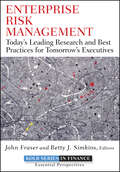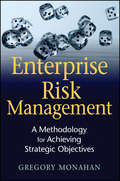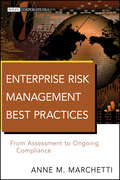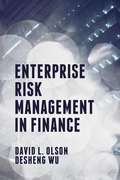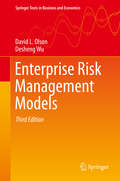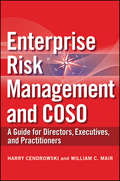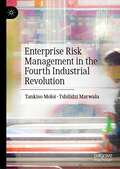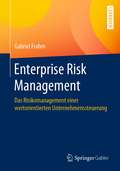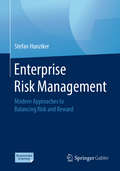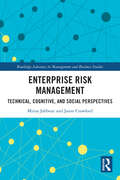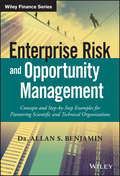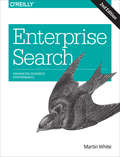- Table View
- List View
Enterprise Risk Management
by John Fraser Betty SimkinsEssential insights on the various aspects of enterprise risk management If you want to understand enterprise risk management from some of the leading academics and practitioners of this exciting new methodology, Enterprise Risk Management is the book for you. Through in-depth insights into what practitioners of this evolving business practice are actually doing as well as anticipating what needs to be taught on the topic, John Fraser and Betty Simkins have sought out the leading experts in this field to clearly explain what enterprise risk management is and how you can teach, learn, and implement these leading practices within the context of your business activities. In this book, the authors take a broad view of ERM, or what is called a holistic approach to ERM. Enterprise Risk Management introduces you to the wide range of concepts and techniques for managing risk in a holistic way that correctly identifies risks and prioritizes the appropriate responses. This invaluable guide offers a broad overview of the different types of techniques: the role of the board, risk tolerances, risk profiles, risk workshops, and allocation of resources, while focusing on the principles that determine business success. This comprehensive resource also provides a thorough introduction to enterprise risk management as it relates to credit, market, and operational risk, as well as the evolving requirements of the rating agencies and their importance to the overall risk management in a corporate setting. Filled with helpful tables and charts, Enterprise Risk Management offers a wealth of knowledge on the drivers, the techniques, the benefits, as well as the pitfalls to avoid, in successfully implementing enterprise risk management. Discusses the history of risk management and more recently developed enterprise risk management practices and how you can prudently implement these techniques within the context of your underlying business activities Provides coverage of topics such as the role of the chief risk officer, the use of anonymous voting technology, and risk indicators and their role in risk management Explores the culture and practices of enterprise risk management without getting bogged down by the mathematics surrounding the more conventional approaches to financial risk management This informative guide will help you unlock the incredible potential of enterprise risk management, which has been described as a proxy for good management.
Enterprise Risk Management
by Gregory MonahanWritten for enterprise risk management (ERM) practitioners who recognize ERM?s value to their organization, Enterprise Risk Management: A Methodology for Achieving Strategic Objectives thoroughly examines operational risk management and allows you to leverage ERM methodology in your organization by putting author and ERM authority Gregory Monahan's Strategic Objectives At Risk (SOAR) methodology to work. A must-read for anyone interested in risk management as a strategic, value-adding tool, this no-nonsense book shows you how to use ERM and SOAR to empower your company to go from stuck to competitive.
Enterprise Risk Management
by James LamA fully revised second edition focused on the best practices of enterprise risk managementSince the first edition of Enterprise Risk Management: From Incentives to Controls was published a decade ago, much has changed in the worlds of business and finance. That's why James Lam has returned with a new edition of this essential guide. Written to reflect today's dynamic market conditions, the Second Edition of Enterprise Risk Management: From Incentives to Controls clearly puts this discipline in perspective.Engaging and informative, it skillfully examines both the art as well as the science of effective enterprise risk management practices. Along the way, it addresses the key concepts, processes, and tools underlying risk management, and lays out clear strategies to manage what is often a highly complex issue.Offers in-depth insights, practical advice, and real-world case studies that explore the various aspects of ERMBased on risk management expert James Lam's thirty years of experience in this fieldDiscusses how a company should strive for balance between risk and returnFailure to properly manage risk continues to plague corporations around the world. Don't let it hurt your organization. Pick up the Second Edition of Enterprise Risk Management: From Incentives to Controls and learn how to meet the enterprise-wide risk management challenge head on, and succeed.
Enterprise Risk Management Best Practices
by Anne M. MarchettiHigh-level guidance for implementing enterprise risk management in any organizationA Practical Guide to Risk Management shows organizations how to implement an effective ERM solution, starting with senior management and risk and compliance professionals working together to categorize and assess risks throughout the enterprise. Detailed guidance is provided on the key risk categories, including financial, operational, reputational, and strategic areas, along with practical tips on how to handle risks that overlap across categories. Provides high-level guidance on how to implement enterprise risk management across any organizationIncludes discussion of the latest trends and best practicesFeatures the role of IT in ERM and the tools that are available in both assessment and on-going complianceDiscusses the key challenges that need to be overcome for a successful ERM initiativeWalking readers through the creation of ERM architecture and setting up on-going monitoring and assessement processes, this is an essential book for every CFO, controller and IT manager.
Enterprise Risk Management In Finance
by David L. Olson Desheng Dash WuEnterprise Risk Management in Finance is a guide to measuring and managing Enterprise-wide risks in financial institutions. Financial institutions operate in a unique manner when compared to other businesses. They are, by the nature of their business, highly exposed to risk at every level, and indeed employ their own risk management functions to manage many of these risks. However, financial firms are also highly exposed at enterprise level. Traditional approaches and frameworks for ERM are flawed when applied to banks, asset managers or insurance houses, and a different approach is needed. This new book provides a comprehensive, technical guide to ERM for financial institutions. Split into three parts, it first sets the scene, putting ERM in the context of finance houses. It will examine the financial risks already inherent in banking, and then insurance operations, and how these need to be accounted for at a floor and enterprise level. The book then provides the necessary tools to implement ERM in these environments, including performance analysis, credit analysis and forecasting applications. Finally, the book provides real life cases of successful and not so successful ERM in financial institutions. Technical and rigorous, this book will be a welcome addition to the literature in this area, and will appeal to risk managers, actuaries, regulators and senior managers in banks and financial institutions.
Enterprise Risk Management Models
by David L. Olson Desheng WuEnterprise risk management has always been important. However, the events of the 21st Century have made it even more critical. The top level of business management became suspect after scandals at ENRON, WorldCom, and other business entities. Financially, many firms experienced difficulties from bubbles. The problems of interacting cultures demonstrated risk from terrorism as well, with numerous terrorist attacks, to include 9/11 in the U.S. Risks can arise in many facets of business. Businesses in fact exist to cope with risk in their area of specialization. Financial risk management has focused on banking, accounting, and finance. We have discussed several aspects of risk, to include information systems, disaster management, and supply chain perspectives. The bulk of this book is devoted to presenting a number of operations research models that have been (or could be) applied to enterprise supply risk management, especially from the supply chain perspective.
Enterprise Risk Management Models
by David L. Olson Desheng Dash WuThis book is a comprehensive guide to several aspects of risk, including information systems, disaster management, supply chain and disaster management perspectives. A major portion of this book is devoted to presenting a number of operations research models that have been (or could be) applied to enterprise supply risk management, especially from the supply chain perspective. Each chapter of this book can be used as a unique module on a different topics with dedicated examples, definitions and discussion notes. This book comes at a time when the world is increasingly challenged by different forms of risk and how to manage them. Events of the 21st Century have made enterprise risk management even more critical. Risks such as suspicions surrounding top-management structures, financial and technology bubbles (especially since 2008), as well as the demonstrated risk from terrorism, such as the 9/11 attack in the U. S. as well as more recent events in France, Belgium, and other locations in Europe, have a tremendous impact on many facets of business. Businesses, in fact, exist to cope with risk in their area of specialization.
Enterprise Risk Management Models
by David L. Olson Desheng WuEnterprise risk management has always been important. However, the events of the 21st Century have made it even more critical. The top level of business management became suspect after scandals at ENRON, WorldCom, and other business entities. Financially, many firms experienced difficulties from bubbles. The problems of interacting cultures demonstrated risk from terrorism as well, with numerous terrorist attacks, to include 9/11 in the U.S. Risks can arise in many facets of business. Businesses in fact exist to cope with risk in their area of specialization. Financial risk management has focused on banking, accounting, and finance. We have discussed several aspects of risk, to include information systems, disaster management, and supply chain perspectives. The bulk of this book is devoted to presenting a number of operations research models that have been (or could be) applied to enterprise supply risk management, especially from the supply chain perspective.
Enterprise Risk Management Models (Springer Texts in Business and Economics)
by David L. Olson Desheng WuThis book offers a comprehensive guide to several aspects of risk, including information systems, disaster management, supply chain and disaster management perspectives. A major portion of the book is devoted to presenting a number of operations research models that have been (or could be) applied to enterprise supply risk management, especially from the supply chain perspective. Each chapter of this book can be used as a stand-alone module on a respective topic, with dedicated examples, definitions and discussion notes. This book comes at a time when the world is increasingly challenged by different forms of risk and how to manage them. Events of the 21st Century have made enterprise risk management even more critical. Risks such as suspicions surrounding top-management structures, financial and technology bubbles (especially since 2008), as well as the risk posed by terrorism, such as the 9/11 attacks in the U.S. as well as more recent events in France, Belgium, and other European countries, have a tremendous impact on many facets of business. Businesses, in fact, exist to cope with risk in their area of specialization.
Enterprise Risk Management Models (Springer Texts in Business and Economics)
by David L. Olson Desheng Dash WuThis book is a comprehensive guide to several aspects of risk, including information systems, disaster management, supply chain and disaster management perspectives. A major portion of this book is devoted to presenting a number of operations research models that have been (or could be) applied to enterprise supply risk management, especially from the supply chain perspective. Each chapter of this book can be used as a unique module on a different topics with dedicated examples, definitions and discussion notes.This book comes at a time when the world is increasingly challenged by different forms of risk and how to manage them. Events of the 21st Century have made enterprise risk management even more critical. Risks such as suspicions surrounding top-management structures, financial and technology bubbles (especially since 2008), as well as the demonstrated risk from terrorism, such as the 9/11 attack in the U.S. as well as more recent events in France, Belgium, and other locations in Europe, have a tremendous impact on many facets of business. Businesses, in fact, exist to cope with risk in their area of specialization.
Enterprise Risk Management Models: Focus on Sustainability (Springer Texts in Business and Economics)
by David L. Olson Desheng WuThis textbook, now in its fourth edition, serves as a comprehensive guide to learning various aspects of risk, encompassing supply chain management, artificial intelligence, and sustainability. It demonstrates a wide range of operations research models that have been successfully applied to enterprise supply chain risk management. Each chapter of the book can function as a standalone module focusing on a specific topic, offering dedicated examples, definitions, and discussion notes.The publication of this book comes at a crucial time when the world is facing increasing challenges from various forms of risk. Events such as Covid-19, the energy crisis, wars, and terrorism in the 21st century have all disrupted supply chains, thus highlighting the critical importance of enterprise risk management. Additional risks, such as financial and technological bubbles, along with concerns surrounding rampant artificial intelligence, contribute to a climate that demands enhanced risk management within organizations.
Enterprise Risk Management and COSO
by Harry Cendrowski William C. MairPraise for Enterprise Risk Management and COSO: A Guide for Directors, Executives, and Practitioners"Enterprise Risk Management and COSO is a comprehensive reference book that presents core management of risk tools in a helpful and organizedway. If you are an internal auditor who is interested in risk management, exploring this book is one of the best ways to gain an understanding of enterprise risk management issues."--Naly de Carvalho, FSA Times"This book represents a unique guide on how to manage many of the critical components that constitute an organization's corporate defense program."--Sean Lyons, Corporate Defense Management (CDM) professional"This book provides a comprehensive analysis of enterprise risk management and is invaluable to anyone working in the risk management arena. It provides excellent information regarding the COSO framework, control components, control environment, and quantitative risk assessment methodologies. It is a great piece of work."--J. Richard Claywell, CPA, ABV, CVA, CM&AA, CFFA, CFD"As digital information continues its exponential growth and more systems become interconnected, the demand and need for proper risk management will continue to increase. I found the book to be very informative, eye-opening, and very pragmatic with an approach to risk management that will not only add value to all boards who are maturing and growing this capability, but also will provide them with competitive advantage in this important area of focus."--David Olivencia, President, Hispanic IT Executive CouncilOptimally manage your company's risks, even in the worst of economic conditions.There has never been a stronger need for sound risk management than now. Today's organizations are expected to manage a variety of risks that were unthinkable a decade ago. Insightful and compelling, Enterprise Risk Management and COSO reveals how to:Successfully incorporate enterprise risk management into your organization's cultureFoster an environment that rewards open discussion of risks rather than concealment of themQuantitatively model risks and effectiveness of internal controlsBest discern where risk management resources should be dedicated to minimize occurrence of risk-based eventsTest predictive models through empirical data
Enterprise Risk Management at Hydro One (A)
by Anette MikesAn early adopter of Enterprise Risk Management, energy giant Hydro One anticipated new threats and opportunities in an industry that faced climate change and carbon legislation, the deregulation of electricity markets, and the greater adoption of renewable technologies. CEO Laura Formusa felt Hydro One's risk profile had shifted, to the extent that she had to ask herself -- was the strategy tenable? The case provides a rich description of Enterprise Risk Management in action, and shows how Hydro One executives arrive at a shared understanding of the risk profile of the company. In the narrative a diverse group of managers (the chief executive, the chief financial officer, the head of the public relations and the chief regulatory officer) voice their views on the risks, collectively bringing a multiple stakeholder perspective to the risk profile. The case challenges students to define the problems and risks that the company faces, given its strategic objectives, its evolving risk profile, and the changing environment. The case also offers a discussion ground for defining the role of the chief risk officer, and the relationship between risk management, strategic planning and capital budgeting.
Enterprise Risk Management in the Fourth Industrial Revolution
by Tshilidzi Marwala Tankiso MoloiThis book examines enterprise risk management in the fourth industrial revolution, and the technologies associated with this phenomenon. In doing so, it seeks to understand these technologies' potential capabilities, and how they could be utilised in the enterprise risk management setting. With this, the book first details the fourth industrial revolution (4IR), and discusses the concept of enterprise risk management, the stakeholders involved, the typical information stakeholders will be responsible for, and their role in integrating risk management information. The book then examines the information processing steps and the new capabilities in the enterprise risk setting necessitated by the capabilities of the 4IR technologies to harness, analyse and integrate information for decision-making and understanding internal and external contexts. In the final chapter, the book conceptualises enterprise risk management in the 4IR, and maps out potential role changes in this space.
Enterprise Risk Management in the Global Supply Chain (The Global Warrior Series)
by Thomas A. CookThere is a younger generation who has lost the ability to communicate effectively. And there is a host of corporate personnel that could do a much better job at communications. Every country, every culture has it's own unique branding for communication that is effective and gets the job done. Key cultures and regions will be reviewed in great detail. The author knows the frustration that corporate America has in making sure its personnel is communicating effectively ... internally and with vendors and customers in the value chain. Most senior executives, educators and trained professional know that a building block to a company's success, along with an individual's success ... is their ability to communicate effectively. This book will discuss as the foundation ... what the author will refer to as "Responsible Communications". When the student follows the path to responsible communications ... then the communications will deliver results. Results will make the communicating then be more impactful and successful. The book will focus on: delivering more effective presentations and proposals, writing to inform, implement or change behavior and outline all the necessary skill sets required to be an excellent communicator.
Enterprise Risk Management: A Modern Approach (Springer Texts in Business and Economics)
by Robert Rieg Werner Gleißner Ute VaniniThe book helps readers to answer a pressing question for businesses: how can they evaluate risks and opportunities to develop appropriate risk-adjusted strategies that allow them to generate maximum profit at acceptable risk levels? This book focuses on a hands-on approach to risk management which includes a step-by-step guide on how to identify, analyze, quantify and aggregate various risks in organizations. It guides the reader through what-if simulation and scenario analyses as well as Monte Carlo simulations in Excel with applications to traditional non-financial businesses and platform companies like Spotify. This management-oriented perspective sets it apart from often compliance-related textbooks, which mostly focus on financial industries. Its approach is applicable to a wide range of industries and based on a strategic and value-based view of balancing risks and opportunities in businesses. The mathematical and technical details are presented in an easy-to-follow format and illustrated throughout with examples and simple calculations. Additional material for lecturers and students (exercises, cases, templates) is provided online.
Enterprise Risk Management: Advances on its Foundation and Practice
by Terje Aven Shital ThekdiEnterprise Risk Management: Advances on its Foundation and Practice relates the fundamental enterprise risk management (ERM) concepts and current generic risk assessment and management principles that have been influential in redefining the risk field over the last decade. It defines ERM with a particular focus on understanding the nexus between risk, uncertainty, knowledge and performance. The book argues that there is critical need for ERM concepts, principles and methods to adapt to the latest and most influential risk management developments, as there are several issues with outdated ERM theories and practices; problems include the inability to effectively and systematically balance both opportunity and downside performance, or relying too much on narrow probability-based perspectives for risk assessment and decision-making. It expands traditional loss-based risk principles into new and innovative performance-risk frameworks, and presents fundamental risk principles that have recently been developed by the Society for Risk Analysis (SRA). All relevant statistical and risk concepts are clearly explained and interpreted using minimal mathematical notation. The focus of the book is centered around ideas and principles, more than technicalities. The book is primarily intended for risk professionals, researchers and graduate students in the fields of engineering and business, and should also be of interest to executive managers and policy makers with some background in quantitative methods such as statistics.
Enterprise Risk Management: Das Risikomanagement einer wertorientierten Unternehmenssteuerung
by Gabriel FrahmDas Buch stellt Methoden zur Messung von Unternehmensrisiken sowie die Grundlagen einer wertorientierten Unternehmenssteuerung aus der Sicht des Risikomanagements vor. Eine kapitelweise Lernkontrolle ermöglicht den Lernerfolg. Anhand von Fallstudien wird die Praxisrelevanz eines holistischem Enterprise Risk Managements veranschaulicht.
Enterprise Risk Management: Modern Approaches to Balancing Risk and Reward
by Stefan HunzikerThis textbook demonstrates how Enterprise Risk Management creates value in strategic- and decision-making-processes. The author introduces modern approaches to balancing risk and reward based on many examples of medium-sized and large companies from different industries. Since traditional risk management in practice is often an independent stand-alone process with no impact on decision-making processes, it is unable to create value and ties up resources in the company unnecessarily. Herewith, he serves students as well as practitioners with modern approaches that promote a connection between ERM and corporate management. The author demonstrates in a didactically appropriate manner how companies can use ERM in a concrete way to achieve better risk-reward decisions under uncertainty. Furthermore, theoretical and psychological findings relevant to entrepreneurial decision-making situations are incorporated. This textbook has been recommended and developed for university courses in Germany, Austria and Switzerland.
Enterprise Risk Management: Modern Approaches to Balancing Risk and Reward
by Stefan HunzikerThis textbook demonstrates how Enterprise Risk Management creates value in strategic- and decision-making-processes. The author introduces modern approaches to balancing risk and reward based on many examples of medium-sized and large companies from different industries. Since traditional risk management in practice is often an independent stand-alone process with no impact on decision-making processes, it is unable to create value and ties up resources in the company unnecessarily. Herewith, he serves students as well as practitioners with modern approaches that promote a connection between ERM and corporate management. The author demonstrates in a didactically appropriate manner how companies can use ERM in a concrete way to achieve better risk-reward decisions under uncertainty. Furthermore, theoretical and psychological findings relevant to entrepreneurial decision-making situations are incorporated. This textbook has been recommended and developed for university courses in Germany, Austria and Switzerland.
Enterprise Risk Management: Modern Approaches to Balancing Risk and Reward
by Stefan HunzikerThis textbook demonstrates how Enterprise Risk Management creates value in strategic- and decision-making-processes. The author introduces modern approaches to balancing risk and reward, based on many examples of medium-sized and large companies from different industries. Since traditional risk management in practice is often an independent stand-alone process with no impact on decision-making processes, it is unable to create value and ties up resources in the company unnecessarily. Herewith, he serves students as well as practitioners with modern approaches that promote a connection between ERM and corporate management. The author demonstrates in a didactically appropriate manner how companies can use ERM in a concrete way to achieve better risk-reward decisions under uncertainty. Furthermore, theoretical and psychological findings relevant to entrepreneurial decision-making situations are incorporated. This textbook has been recommended and developed for university courses in Germany, Austria and Switzerland.
Enterprise Risk Management: Technical, Cognitive, and Social Perspectives (Routledge Advances in Management and Business Studies)
by Jason Crawford Mirna JabbourERM is considered a dynamic capability that is critical to companies’ success from strategic and performance perspectives and is increasingly implemented in response to growing pressure from external stakeholders to enact and add legitimacy to existing management control systems. However, implementing ERM is a challenging process where success is dependent on balancing technical and social factors. This book explores the challenges of implementing ERM from technical, cognitive, and social perspectives to enhance the organisation’s capacity to generate and integrate information and knowledge about risk and uncertainty.In existing publications, ERM implementation is mainly viewed from technical or educational perspectives and treated as formal, technical, linear processes. This book takes a different stance by recognising that implementation depends on formal and informal mechanisms that require a balanced combination of technical and social approaches. It changes the paradigm to demonstrate that the implementation of ERM is not a linear process that is similar across industries and organisations, but relies on multiple dependencies such as leadership, corporate governance, and the culture of the organisation.This book will be a valuable resource for scholars, as well as upper-level students, across disciplines related to risk management, including accounting and finance, business and management, leadership, and organisational studies.
Enterprise Risk Management: Today's Leading Research and Best Practices for Tomorrow's Executives (Robert W. Kolb Ser.)
by Rob Quail John R.S. Fraser Betty J. SimkinsUnlock the incredible potential of enterprise risk management There has been much evolution in terms of ERM best practices, experience, and standards and regulation over the past decade. Enterprise Risk Management: Today’s Leading Research and Best Practices for Tomorrow’s Executives, Second Edition is the revised and updated essential guide to the now immensely popular topic of enterprise risk management (ERM). With contributions from leading academics and practitioners, this book offers insights into what practitioners are doing and what the future holds. You’ll discover how you can implement best practices, improve ERM tools and techniques, and even learn to teach ERM. Retaining the holistic approach to ERM that made the first edition such a success, this new edition adds coverage of new topics including cybersecurity risk, ERM in government, foreign exchange risk, risk appetite, innovation risk, outsourcing risk, scenario planning, climate change risk, and much more. In addition, the new edition includes important updates and enhancements to topics covered in the first edition; so much of it has been revised and enhanced that it is essentially an entirely new book. Enterprise Risk Management introduces you to the concepts and techniques that allow you to identify risks and prioritize the appropriate responses. This invaluable guide offers a broad overview, covering key issues while focusing on the principles that drive effective decision making and determine business success. This comprehensive resource also provides a thorough introduction to ERM as it relates to credit, market, and operational risk, as well as the evolving requirements of the board of directors’ role in overseeing ERM. Through the comprehensive chapters and leading research and best practices covered, this book: Provides a holistic overview of key topics in ERM, including the role of the chief risk officer, development and use of key risk indicators and the risk-based allocation of resources Contains second-edition updates covering additional material related to teaching ERM, risk frameworks, risk culture, credit and market risk, risk workshops and risk profiles and much more. Over 90% of the content from the first edition has been revised or enhanced Reveals how you can prudently apply ERM best practices within the context of your underlying business activities Filled with helpful examples, tables, and illustrations, Enterprise Risk Management, Second Edition offers a wealth of knowledge on the drivers, the techniques, the benefits, as well as the pitfalls to avoid, in successfully implementing ERM.
Enterprise Risk and Opportunity Management: Concepts and Step-by-Step Examples for Pioneering Scientific and Technical Organizations
by Dr Allan S. BenjaminRisk management strategy for the pioneering technological sector Enterprise Risk and Opportunity Management provides much-needed guidance tailored specifically to the technological sector. While most enterprise risk management guides are written for traditional businesses and finance firms, this book translates effective enterprise risk and opportunity management (EROM) principles into strategies and practices that work for government, nonprofit, and for-profit organizations in the technological space. Originally designed for noncommercial pioneering enterprises like NASA, an entire chapter is now devoted toward applying the methods to profit-making technological enterprises. A 40-year veteran of the tech sector, Dr. Allan Benjamin outlines risk management strategies for organizations in which the advancement and integration of science and technology within complex systems is necessary for accomplishment of the mission. Commercial EROM strategies do not translate directly when the development and implementation of risky technologies is the organization's primary objective, and clumsy or near-sighted implementation can easily cripple progress. This book provides authoritative guidance tailored to the sector's specialized needs. Maximize opportunity while effectively managing risk Understand the core principles of the technological EROM approach and its interfaces with the management of the organization Comprehend the intricacies of aggregating risks and opportunities from lower to higher levels of the organization Gain expert insights specific to the technology sector Mitigate and control the risk that comes with pursuing discovery In practice, EROM in this sector involves working with mostly qualitative data, and is characterized by high uncertainty. Managing risk without handicapping the organization requires a specific set of adjustments to traditional EROM, and a more nuanced approach to the idea of "acceptable risk. Balance is key in technological EROM, and Enterprise Risk and Opportunity Management provides foundational guidance, real-world strategy, and enlightening examples for getting it right.
Enterprise Search: Enhancing Business Performance
by Martin WhiteIs your organization rapidly accumulating more information than you know how to manage? This updated edition of Enterprise Search helps you create an enterprise search solution based on more than just technology. Author Martin White shows you how to plan and implement a managed search environment that meets the needs of your business and your employees. You'll learn why it’s absolutely vital to have a dedicated staff manage your search technology and support your users.New material for this second edition includes material on SharePoint 2013 search, managing open source search development, website search, designing the search user, and assessing search performance. Chapters now include a Further Reading section for computer science and information science students.Topics include:10 critical success factors to assess organizational search maturityEssential skills needed to support a successful search applicationHow to specify and manage open source search developmentHow to manage SharePoint 2013 searchMethods to assess the business impact of searchBest practices in user interface designThe importance of search for websitesWhat to include in a search strategy
